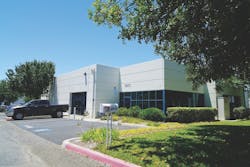Ousting Odor With Ozone
Without odor control, wastewater treatment plants have a characteristic smell. In most plants, anaerobic digestion is used in the treatment process, and a specific strain of bacteria creates that smell.
These are known as sulfate reducing bacteria (SRB). They can only metabolize and live in zero-oxygen conditions. In these conditions, they produce hydrogen sulfide, which leads to the odor common in wastewater treatment facilities without odor control. Paul Turgeon, CEO of Anue Water Technologies, said that by-product can also be dangerous for operators.
“Sulfides can actually be toxic, so when you think of a wet well or a chamber that has sulfides accumulating in it, it could actually injure or kill a human. That’s how toxic sulfides are in pretty low concentrations,” Turgeon said.
Traditionally, treatment plants have used chemicals to combat this odor. Those chemicals, however, do not kill the bacteria. Instead, they change the metabolic cycle of the SRBs to cut down the bad smell by reducing the nitrate in the digester. These chemicals have worked for many facilities looking to reduce the corrosive and noxious nature of anaerobic digesters.
Over time, the bacteria adapt to these chemicals and the odor control loses effectiveness. More chemicals can be used to keep the same effectiveness, but that can become an added expense, which is not always feasible.
“Over the course of time, they have to use more and more of these chemicals, and they’re scratching their heads as to why that is, and it becomes very, very expensive,” Turgeon said, noting this opened a door to exploring alternatives.
Ozone Alternative
To combat these costs, some facilities have started adding oxygen into the treatment process as a means to kill SRBs.
“An apparatus that goes onsite generates ozone and oxygen, and so you can get away from the practice of continually buying chemicals,” Turgeon said. “Oxygen will be injected into the force main, and the reason that you do that is to keep it aerobic, which is toxic to anaerobic SRBs.”
Unlike chemicals that change the metabolic nature of the SRBs, oxygen changes the environment andultimately kills the bacteria to eliminate the odor and limit the generation of hydrogen sulfide. Turgeon said this technology creates environments where SRBs cannot survive.
However, SRBs are resourceful and can find nooks and crannies where there is no oxygen. The bulk fluid portions of a treatment process may be free of SRBs, but the bacteria could find a home under a deposit or sludge where the oxygen is not penetrating. This, Turgeon said, is where ozone enters the equation.
Injecting ozone into lift stations in the vapor phase will encourage oxygen to penetrate those hard-to-reach places and kill the SRBs.
“You’ve taken a two-step process. You’are maintaining aerobic conditions in the force mains, and at the lift stations, if there is any residual potential for the SRBs to still be living in nooks and crannies, then the ozone negates any sulfide generation by reaction,” Turgeon said. “[And] the ozone, if it’s not fully used, also treats some of the fluid so that any SRBs present [die]. Ozone’s a strong disinfectant, so it will also give some disinfecting properties. So there’s two weapons in the arsenal and they work well together.”
Monitoring & Alarms
Turgeon said these systems and proprietary knowledge of their ins and outs can benefit municipalties looking to slash chemical costs while maintaining a good odor control system. The electronics, he said, monitor the injection of oxygen and ozone into the system and can provide real-time updates, which can be accessed remotely.
In the event that a municipality needs additional help maintaining the systems, companies like Anue Water Technologies also offer packages to monitor the system and send alarms or alerts if something goes wrong.
“We will watch the system and the system operation dynamics, and if there are alarm conditions, then we get involved to help them deal with that,” Turgeon said.
The hardware, he said, is reliable and, over the course of time, may require a tune-up, and some parts may need to be replaced as they experience normal wear and tear. Service programs to replace them are proactive in fixing systems to limit downtime and keep the facility operational.
Growth Opportunities
What originally began as a regional business has gained popularity, Turgeon said. Customer reactions have been positive, with many excited about reducing or eliminating chemical costs for odor control.
There are 50 applications in the U.S., he added, noting word of mouth has led to opportunities in Canada and Australia. Awareness is the critical factor in finding more application uses, and with regular iterations of the technology—looking for improvements in efficiencies and capacity—the market for it will continue to grow.
